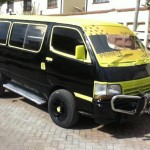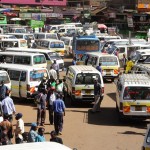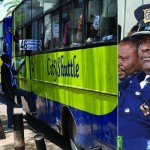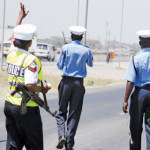 In many parts of western Kenya the car boot has found a new use; packing up to four passengers and no one is complaining about it.
In many parts of western Kenya the car boot has found a new use; packing up to four passengers and no one is complaining about it.
After being used to Nairobi’s chaotic but ‘organised’ public transport system, one is shocked by the calamity that is matatus and buses in other parts of the country.
Getting into one of these contraptions requires courage and a thick skin to stand the torture meted on passengers.
Over time, passengers have got used to this style of travelling. Otherwise, how do you explain when respectful men and women crouch into a packed boot of a station wagon?
When in 2003 the then Minister for transport John Michuki gazetted rules to streamline the sector, there was some bit of sanity. But this, it seems, was not for the rural operators whose other name is impunity.
The public transport anarchy in Nyanza, Rift Valley and Western provinces is unrivalled.
The daredevil drivers and touts in the streets of Nairobi are angels when you compare them with these ones. It is normal in Kisumu, Kakamega, Siaya, Eldoret or Kisii for a 14-seater matatu to carry more than 20 travellers, thanks to a plank usually placed on the aisles, locally referred to as sambaza.
This seat carries the fourth person in every row. Two more people squeeze in and travel standing.
From the look of things, the passengers and crew are not worried about breaking the famous ‘Michuki’ rules. Perhaps police officers, who are charged with ensuring traffic laws are followed to the letter are overwhelmed and look the other way when such vehicles that blatantly break laws zoom past.
Nyanza provincial traffic enforcement officer Martin Kinoti says he is not aware if vehicles carry excess passengers.
“Matatu crews have become shrewd. They probably overload once they pass the police road checks,” he says, adding, “We do not condone corrupt practices by traffic officers.”
Kinoti asserts that in the recent past, eleven officers under his command were transferred due to corruption allegations.
Fatal accidents
The Kisumu-Kakamega-Mumias-Luanda route is a testimony of the impunity that matatu crews bask in. Apart from overloading passengers, the vehicles stop in the middle of the road to pick and drop passengers. This could lead to fatal accidents.
One conductor told this writer that they had to overload and make that extra money for the police along the roads — another ‘normal’ part of the business.
From Mumias to Sabatia in Butere, the Toyota Probox is the ‘matatu’.
The vehicle is designed to carry five passengers but it is usually packs ten. I boarded one and got into the boot, joined three other and we were all packed like sardines. I expected to be stopped and arrested for breaking the law; but I was disappointed when I reached my destination without much ado.
Western provincial traffic enforcement officer Rhoda Kananu blames the public for this state of affairs.
“Passengers know too well that they should not board these small vehicles unless they are being used as taxis within town but they don’t care,” she said.
Eight-seater vehicles are even worse; they are commonly referred to as ‘kangaroos’ or ‘nguruwe’. I boarded one to Luanda at Sabatia in Butere. We were four passengers per row; three more people were standing as the tout hang precariously on the door.
The driver was seated with three more passengers in front. The driver kept speeding so much that passengers cautioned him, only for the tout to tell us that we had no experience in driving. In essence, one of the Michuki rules, all matatus must have speed governors, was forgotten as soon as the rules became law.
To hoodwink the police and passengers, the operators have a speedometer that will never go beyond the specified 80km per hour mark, even if the vehicle is hurtling well beyond 100km per hour.
Peter Shitandi, a passenger, says travelling by matatus is a nightmare, a necessary devil that passengers can’t do without.
“The conductors and touts threaten us when we complain and the traffic officers don’t come to our rescue because they are friends,” says Shitandi.
Most drivers and conductors are rarely in uniform, wear no tags and are unkempt. If a passenger dares ask for these, he or she is forced to alight.
No respect
Business woman Anne Achieng’ operates between Kisumu and Busia, where she travels daily to pick her merchandise. Although it is cheaper to use public transport, she says, the stress she has endured for the last five years is too much.
“You can’t afford to complain or be inquisitive; they can mark you and can never give you a ride,” says Achieng’.
Some passengers are concerned that most matatus crews are young men — these young people have no respect for others and are rowdy.
“They are forceful and can’t be tamed by anybody, not even the police. Any crackdown makes them vent their wrath on innocent civilians,” an elderly passenger tells me after ensuring the crew is out of earshot.
Sometimes there are police crackdowns but these achieve nought as operators simply withdraw vehicles from the roads until after it is over. Then the faulty vehicles are returned to the road; it is business as usual.
Mary Omar, the Rift Valley Provincial Traffic Enforcement Officer notes that the public flout traffic rules. They use mundane excuses to break the law. Some argue that they are getting late so they’d rather travel in an overloaded vehicle.
“In cases of accidents, the very public point accusing fingers at the police,” she charges. Furthermore, she says, the passengers usually take sides with errant matatu drivers making the officers’ work difficult.
She says officers cannot be everywhere and it is upon passengers to obey traffic rules before pointing accusing fingers.









![The PSV motorshow & Nganya Awards 2013 [VOTE]](../../../blog/wp-content/uploads/2013/11/Nganya-Awards-2013-150x150.jpg)
